I finally got a chance to see The Great Gatsby and while I loved the movie I was disappointed by the inaccuracy of the men’s evening wear. Normally I would chalk this up to sloppy research but that doesn’t seem likely considering that the film’s double Academy Award-winning costumer designer Catherine Martin based her creations on the extensive collection of images and products in the Brooks Brothers archives. That leads me to believe that the unorthodox attire was a matter of artistic licence. But to what end?
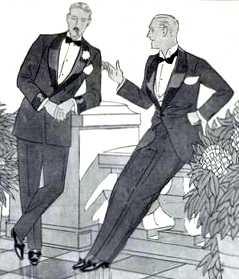
Summer dinner wear options from the July 1922 issue of Vanity Fair. (NYPL Digital Gallery, Image ID 817180)
The Vanity Fair illustration above is a perfect example of prevailing formal wear trends for the summer of 1922, the period during which Gatsby takes place. Clearly Martin has accurately captured the era’s strict black-and-white palette and the single-breasted jacket’s one-button styling. She has also reflected the period’s predominant lapel styles of peaks and shawls – no common notch lapels here.
Where she veers from historical authenticity is in the details of the shirt and waistcoat. While it’s true that some young mavericks of the time were experimenting with soft-front turndown collar evening shirts, this development was generally frowned upon. Vanity Fair was being very forgiving compared to other contemporary authorities when it said of dinner shirts for American summers:
So far as the collar is concerned, either of those shown is correct; it is a matter of which is the more comfortable. Many men find a wing collar, with a very wide opening, as comfortable as the turn-over collar, and it is undoubtedly the most correct for evening wear.
By dressing virtually all the men in turndown collars instead of stiff-front wing-collar shirts, Martin is presenting the opposite of what actually took place. (An archival catalogue illustration of a 1920s Brooks Brothers dinner jacket with turndown-collar shirt has been widely circulated as part of the film’s promotional material and would seem to validate Martin’s choice. In actual fact the illustration dates from the 1950s.)
Granted, this is not a particularly detrimental creative choice and has at least some historical basis. The same cannot be said for the waistcoat styles.
Evening waistcoats at this time were deliberately cut very low so as to not obscure the formal shirt front, making them virtually invisible when the jacket was buttoned. So why is it that all the men in the film sport high-cut models that were worn only with informal suits prior to the 1970s?
Worse than being inaccurate, Martin’s choice of waistcoat styling is inelegant. Considering all the time, money, and effort that was put into recreating the era’s sophisticated cars, furnishings, and clothing, it is a mystery as to why she opted to demote the tuxedos to the level of pedestrian business suits. Instead of the traditionally striking look of a deep “V” of white shirt front framed by the lapels of a one-button tuxedo which mimics the ideal male torso, Martin’s chest-high vests turn the outfits into a monotonous sea of black. And if this was such a good idea, why is it that Brooks Brothers’ very own Gatsby-themed clothing line features a properly cut waistcoat?
(If I wanted to get really picky I would also ask why the Tom Buchanan character was wearing any type of waistcoat with his double-breasted dinner jacket when the whole point of this new type of warm-weather coat was to eliminate the need for an additional layer of wool beneath. And why did Martin completely ignore the period’s distinctively glamorous trend of wearing white waistcoats with black tie?)
Perhaps the special features on the eventual DVD release will reveal how Ms. Martin came to mar her otherwise outstanding costume design with this lamentable decision.
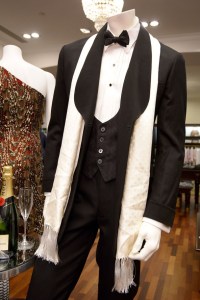
Gatsby costumes on display at Brooks Brothers flagship stores are conspicuously devoid of the incorrect evening waistcoat styles seen in the film. (Rex Features | Vogue UK)
________________________________________
Postscript
This is a still from the behind-the-scenes video with Catherine Martin showing Di Caprio’s three-button jacket and clavicle-covering vest. In the video she describes Gatsby as “the immaculate dresser. Somebody who bases himself on English royalty”. Apparently Ms. Martin is unaware that English royalty wouldn’t have been caught dead in such an unorthodox outfit after six. In fact, if they were in mixed company the royals would have been dressed in white tie – the way Robert Redford’s Gatsby was in the 1974 version of the film.
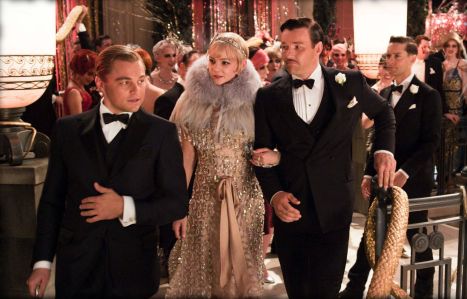
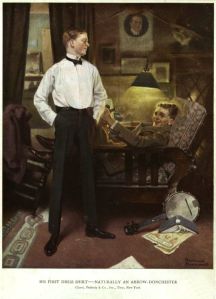
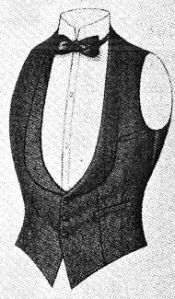
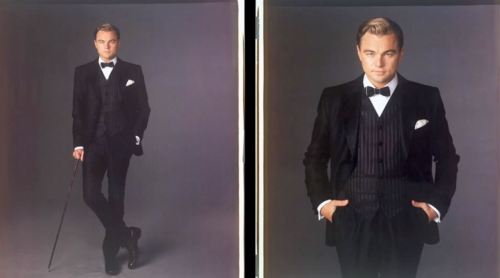
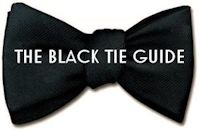
Hal
June 10, 2013
I think you are, if anything, being too kind to the evening suits on display, here.
For one thing, di Caprio’s dinner jacket appears to have three buttons (he buttons the top two) – exactly the same as all his other suits in the movie. This is a deliberate choice because the other single breasted dinner jackets do only have one button to fasten them.
That, perhaps, makes the high fronted waistcoat for Gatsby more understandable. That said, I didn’t care for it when I first saw the high waistcoat and I still don’t. Given that the costume designs included proper evening waistcoats I can only presume that Luhrmann wanted this style.
There was clearly a decision to go for an anachronistic look – whether that is the high fronted waistcoats, the universal use of double collars (as they’d’ve been called then) or the flat fronted ultra narrow legged trousers. The soundtrack, of course, takes a similar approach. Even numbers such as ‘Let’s Misbehave’ and ‘Ain’t Misbehaving’ are from slightly later than the years the movie seems to be set.
Finally, it seems bizarre that in a movie where clearly care was taken to make it look beautiful that no-one thought to employ a tailor to try and ensure that di Caprio’s suit collar didn’t gape and stand quite so far away from his neck. When seen in close up, it begins to get distracting.
That said, whilst very much Baz Luhrmann’s Gatsby, as opposed to Fitzgerald’s, it was still an enjoyable film and just about the only Luhrmann movie I’ve enjoyed since Strictly Ballroom. It captures something of the Jazz Age spirit, with its frenetic speed, even if that seems to have more in common with Fitzgerald’s earlier work than Gatsby.
Excellent and enjoyable analysis of the evening wear and excellent illustrations, by the way.
Peter Marshall
June 10, 2013
I hadn’t noticed the three-button dinner jacket (shudder) but I did notice the poor fit of the jacket. That’s inexcusable in a film where, in Martin’s own words, “everyone looks like their clothes were made to measure.”
Kate
July 1, 2013
Thank you for this blog post. I think I shall stick with the original Great Gatsby version. I have always been a fan of Robert Redford, and I like that version despite the fact that it is clearly a child of the 1970s. Having said that, one should never trust modern Hollywood when it comes to elegance and etiquette. Hollywood’s Golden Era is long gone, and I was sadly reminded of this fact after watching “To Catch a Thief” yesterday. We simply don’t have costume design icons like Edith Head and Helen Rose anymore.
jovantheun1337
October 6, 2013
No, please, do give this one a try. If you can get past the inaccuracies, it’s actually a pretty good film.
Hal
July 3, 2013
I’ve just noticed that the 1922 illustration appears to show the man in the single breasted shawl collar jacket as having two buttons to fasten (of which he does the top one, as one would a normal lounge suit). Are my eyes deceiving me?
Caleb
February 12, 2014
It’s just like the music. Gatsby was cool, he was hip and displaying that in 2013 is hard… It think its a wise choice to blend what is accurate with the 1920’s with a modern twist. If they would have just made the clothing and music completely authentic to the 1920’s, it would of not appeared cool to the eyes of a 2013 watcher, but rather cheesy, and would of been very much like the unsuccessful Gatsby movies in the past. From reading the books you can see that Gatsby and his parties were extravagant and modern for the time and to get that across to the modern day watcher, they put a new age spin on the roaring twenties. I like the choices they made, I thought the clothes were awesome. If Gatsby was dressed in completely authentic 20’s suits, it would of just looked lame and out of date. But hey, that’s just a young guys perspective.
Hal
February 13, 2014
You are clearly right that the movie makers made a choice with the clothing – as they did with the music – to blend the vintage and the modern to give a 2013 spin on the Jazz Age. I’m just not sure that they did so very successfully when it came to the black tie outifts.
A lot of the clothing in the film was a far more successful blend of the current and ’20s style. Many of Gatsby and Carraway’s clothes were a clever take on the vintage look that also fitted contemporary cuts and the movie deserves credit for that. I’m sure it was a factor that added appeal for an audience that might otherwise have been less interested.
Looking at Gatsby’s dinner jacket, however, I’m struck not only by the fact that it isn’t authentically 1920s but also that it isn’t even an example of good modern style. Gatsby’s three button jacket is a style that was briefly in vogue around the late 90s and millennium – think of Tom Cruise in ‘Eyes Wide Shut’. There are plenty of excellent slim fitting examples of one buttoning dinner jackets about today – why not use one of those? What we have is something both anachronistic and oddly dated.
Lastly, whatever the flaws of previous versions, no-one could accuse the 1970s version of lacking a contemporary style for its clothing. In the same way that the 2013 version used the narrow cut early ’20s look as a mirror to contemporary fashions, so the ’70s version took inspiration from later ’20s style that was closer to the then fashions of the day. The look was, in its day, modern and contemporary, just as Luhrmann’s intends to be.
Alex R
March 2, 2014
You’d think that for an organization made almost entirely of elderly white men, the Academy would know better than to give The Great Gatsby the Oscar for best costume design.